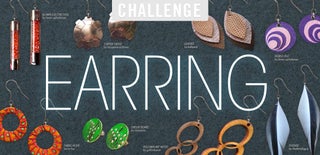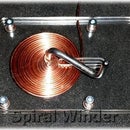Introduction: Coconut Shell Earrings
Making stuff out of coconut shell only takes a few hand tools and none of them have to be power tools. Coconuts are available in most countries as well. The shell is quite hard, but easy to work with metal tools and it polishes to a nice dark lustre (with a bit of extra work, it can even resemble a glazing), so everyone should be able to give it a try.
In the following, I will show you how I made the earrings above, from initial idea to finished state and you should be able to either copy my design (template included), or make an entirely different design - the possible variations are near endless.
Tools used:
- Pencil
- Eraser
- Fineline pen
- Scribe
- Drill bits (0.5mm, 1.5mm, 2mm and 8mm, the last one for forming the earwire)
- Jewellers saw (with a #5 blade)
- Hacksaw (to open the nut)
- Flush cutter
- Flat nose pliers
- Round nose pliers
- Regular file, key file and needle file - all half-round
- Sandpaper 150 and 400 grit
- Nail sanding/polishing block with 4 grit sizes (from roughly 800 grit to very fine)
Materials used:
- Baking paper (for pattern transfer)
- Drawing paper of kinds
- A piece of coconut (inner) shell
- Around 30..40 cm of 0.5mm bronze wire
- Super glue (or epoxy glue)
- Patience
Step 1: Doodle
Whenever you have an idle moment, paper and a pencil, you can doodle weird shapes (just like when you were bored in school).
If you focus a bit on the doodles, you might start seeing patterns or something that can become patterns with a few extra strokes and suddenly, you have the beginning of a design. Keep to it and redraw it and let it evolve from your subconscious mind - I really started from scratch on this project, the proof is in (on) the paper.
Step 2: Refine
I ended up with this design, drew it in pencil until I was satisfied with it, inked it with a fine-line roller pen and when dry, I used an eraser to remove the excess pencil strokes and my loose idea was becoming a bit more tangible.
Step 3: Transfer Your Pattern
To make a symmetrical pair, use baking paper to copy your design. It's easy to see the pattern when turned upside down. You could scan the design and mirror it in a paint program as well, but sometimes it's nice to do simple and keep old ways alive.
The shell will be easier to work with if you file or sand most of the hairy fibers off. It will look fairly light colored due to the fibers and the surface will be rough and hard to draw on (although not too hard). If you have a belt sander or lots of patience to go with a piece of regular sandpaper (grit 100..150), you could even out the outside before you even take a hacksaw to it and dig out the cocos meat (mine was already opened, as I used some of the shell about 6 months ago, so I was spared some work).
Tape the baking paper to the shell with whatever tape you have handy and copy the pattern by scribing through the lines. Start from the inside, as you cut the paper and it is only held at the outside.
If you have no scribe, file a piece of steel, like a nail, to a sharp point. Do not use a sharp knife as a scribe, it is bound to slip on the hard and rounded shell and accidents are almost given that way.
Once you have traced the full pattern, line it up with a pencil, to make it easier to follow when you cut along the lines with a jewellers saw.
Step 4: Cut the Nut
Drill a hole of around 2mm in each inside panel/hole and thread your saw blade through the holes one by one. Saw out the inner panels first, as it is easier when you have more material to grip.
When the inside panels are done, cut along the outside and be very careful when you reach the end, or you might accidentally break off a part of your design.
When both parts are done, compare them with your initial design, to see where you need to file the most material (compare your two pieces of baking paper ahead, to avoid a mistake in the drawing (I did not and had to file that much more).
When the outline and the panels are to your liking, sand the edges as well as the outside and for a dangling earring, you might wanna sand the inside as well.
Using progressively finer grit, go on until you have the lustre you want - some like a matte look, some want mirror polish, but only you can decide what to go for here.
Step 5: Sand, Sand and Sand... Polish, Polish and Polish
When your nut has had enough of you and you think you gave it all you got, you gotta give it a little bit more!
Step 6: Mounting an Eyelet
Make an eyelet in the top of your two pieces. Just drilling a hole for a jump ring is not really my thing, but if you feel lazy and don't mind the look, go with your own methods.
I used cyanoacrylate glue (3 second super glue). 2-component epoxy is probably stronger, but you have to hold the pieces together while it hardens - without getting glue on anything else and that can be a hard job. You also have to mix a lot more glue than what 2 earrings need and why waste.
Step 7: Ear Wire+
Unfortunately, I could not take any photos while making the ear wires and the double looped jump rings, so here they are attached and ready to wear.
Step 8: Wear It With Pride (or Leave That to Someone Else)
As you can see, they are useable, although I will probably upgrade the ear wire to 0.8mm or 0.9mm in silver (replacing all the metal parts), as some are sensitive to bronce.
I drew the pattern digitally as well, if anybody wants to use it, but do scale it down before you print it.
The ones I made are 59mm (2-5/16" or 2.313") tall and 20mm (25/32" or 0.782") wide.
I have attached a pdf-file of my design, as it will be easier to scale to whatever size you want.
So much for my first try at it - have fun with it - but don't laugh too hard at me, please ;)
Any questions? I will try my best to answer.

Runner Up in the
Earring Challenge

Participated in the
Reuse Contest














